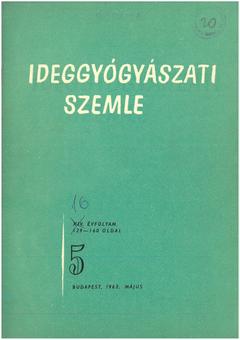The eLitMed.hu medical portal uses computer cookies for convenient operation. Detailed information can be found in the Cookie-policy.
Clinical Neuroscience - 1963;16(05)
Content
[Analysis of 19 cases of syncope]
[In summary, 1. with the exception of the 3 cases with epilepsy, resting electrical activity, even if abnormal, does not appear to be specific and cannot be associated with syncope; 2. syncope, although in the majority of cases an independent pathology, may be associated with epilepsy (cases 1 and 2) and even, we hypothesize, may be a trigger of epilepsy (case 3); In case 3, the electrographic findings support the conclusion that the cause of the malocclusions is, as Gastaut et al. have already shown, cerebral anoxia caused by asystole or bradycardia; 4 Our case 4 suggests that the pathomechanism of cough syncope may involve a vagocardial reflex mechanism; 5. syncope can be induced by Megimide in addition to Cardiazolone. To our present knowledge, there is no link between epilepsy and the pathomechanism of syncope. However, syncope provoked by Cardiazole and Megimide deserves further study in the direction of the nature of the central mechanism that leads to the suspension of cardiac function.]
[Pathologically proven cases of inferior posterior cerebellar artery occlusion. The two types of bulbar s lateralis syndrome]
[In our two clinically classic cases of Wallenberg's syndrome, we established a diagnosis of infernal post-thrombotic occlusion of the cerebellum. In both cases, the pathological findings confirmed that the lateral syndrome observed was caused by infernal post-thrombotic occlusion of the cerebellar. The literature data and our own older observations suggest that there is an upper lateral oblongata syndrome (occlusion of the a. fossae bulbi) and a lower lateral oblongata syndrome due to occlusion of the inf. post. a. cerebelli. In the latter syndrome there is vocal cord paresis, and accordingly in our cases we have demonstrated severe laesions of the middle and lower part of the nucl. ambiguus. ]
[Topical use of streptomycin in the treatment of pain syndromes]
[Authors have reported local pain reduction with streptomycin in the local treatment of laryngeal TB. On the basis of this observation, they have regularly treated post-tooth extraction and neuralgia pain with str. The clinical data of 24 patients with trigeminal neuralgia and 1 patient with glossopharyngeal neuralgia are described in detail. Their observations indicate that the above effect of str. is produced by functional blockade of the nerve pathways that conduct pain. ]
[Cerebral ventricular rupture in hydrocephalus occlusus]
[The authors describe their 25-year case of hydrocephalus. The aquaeductus sylvii was occluded by a 1 mm thick glial membrane, causing occlusive hydrocephalus. During the development of hydrocephalus, spontaneous improvement occurred because the ventricular wall in the left frontal convexity was ruptured and CSF was allowed to be absorbed into the subarachnoid space. In their case, he was familiar with the forms of aquaeductal obstruction, the atrophy of brain matter in hydrocephalus and the outcome, including the possibility of spontaneous recovery.]
1.
Clinical Neuroscience
[Headache registry in Szeged: Experiences regarding to migraine patients]2.
Clinical Neuroscience
[The new target population of stroke awareness campaign: Kindergarten students ]3.
Clinical Neuroscience
Is there any difference in mortality rates of atrial fibrillation detected before or after ischemic stroke?4.
Clinical Neuroscience
Factors influencing the level of stigma in Parkinson’s disease in western Turkey5.
Clinical Neuroscience
[The effects of demographic and clinical factors on the severity of poststroke aphasia]1.
2.
Clinical Oncology
[Pancreatic cancer: ESMO Clinical Practice Guideline for diagnosis, treatment and follow-up]3.
Clinical Oncology
[Pharmacovigilance landscape – Lessons from the past and opportunities for future]4.
5.



